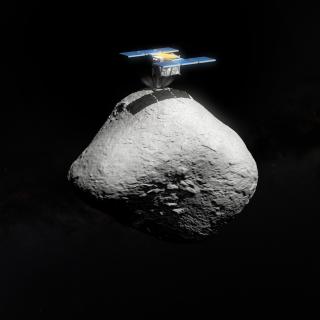It may interest you
-
 Astronomers have used telescopes around the world, includingthe Gran Telescopio Canarias (GTC or Grantecan) at the Roque de los Muchachos Observatory on La Palma, to study the asteroid 1998 KY26, revealing it to be almost three times smaller and spinning much faster than previously thought. The asteroid is the 2031 target for Japan’s Hayabusa2 extended mission. The new observations offer key information for the mission’s operations at the asteroid. “We found that the reality of the object is completely different from what it was previously described as,” says astronomer Toni Santana-Ros, aAdvertised on
Astronomers have used telescopes around the world, includingthe Gran Telescopio Canarias (GTC or Grantecan) at the Roque de los Muchachos Observatory on La Palma, to study the asteroid 1998 KY26, revealing it to be almost three times smaller and spinning much faster than previously thought. The asteroid is the 2031 target for Japan’s Hayabusa2 extended mission. The new observations offer key information for the mission’s operations at the asteroid. “We found that the reality of the object is completely different from what it was previously described as,” says astronomer Toni Santana-Ros, aAdvertised on -
 El Hotel Jardín Tecina de La Gomera ha sido la sede del congreso internacional “Brown dwarfs keep their cool. 30 years of substellar science” , organizado por los investigadores del Instituto de Astrofísica de Canarias (IAC) Nicolas Lodieu y Victor J. S. Bejar, que ha reunido esta primera semana de septiembre a expertos de todo el mundo en el campo de los objetos subestelares. El encuentro conmemora el 30 aniversario de un descubrimiento histórico que marcó un antes y un después en la Astrofísica: la detección de las primeras enanas marrones. El acto inaugural contó con la presencia deAdvertised on
El Hotel Jardín Tecina de La Gomera ha sido la sede del congreso internacional “Brown dwarfs keep their cool. 30 years of substellar science” , organizado por los investigadores del Instituto de Astrofísica de Canarias (IAC) Nicolas Lodieu y Victor J. S. Bejar, que ha reunido esta primera semana de septiembre a expertos de todo el mundo en el campo de los objetos subestelares. El encuentro conmemora el 30 aniversario de un descubrimiento histórico que marcó un antes y un después en la Astrofísica: la detección de las primeras enanas marrones. El acto inaugural contó con la presencia deAdvertised on -
 The four large sized telescopes of the CTAO on La Palma reach a key milestone in their construction The LST-2 telescope has successfully completed the installation of its camera support structure (CSS), making it the last of the four Large Sized Telescopes ( LST ) to reach this important milestone in its construction at the Roque de los Muchachos Observatory of the Instituto de Astrofísica de Canarias (IAC) on La Palma. This telescope is part of the ambitious CTAO ( Cherenkov Telescope Array Observatory ) project, which will create the world's largest network of telescopes for the detectionAdvertised on
The four large sized telescopes of the CTAO on La Palma reach a key milestone in their construction The LST-2 telescope has successfully completed the installation of its camera support structure (CSS), making it the last of the four Large Sized Telescopes ( LST ) to reach this important milestone in its construction at the Roque de los Muchachos Observatory of the Instituto de Astrofísica de Canarias (IAC) on La Palma. This telescope is part of the ambitious CTAO ( Cherenkov Telescope Array Observatory ) project, which will create the world's largest network of telescopes for the detectionAdvertised on
